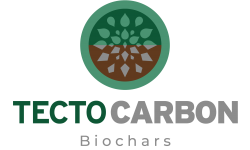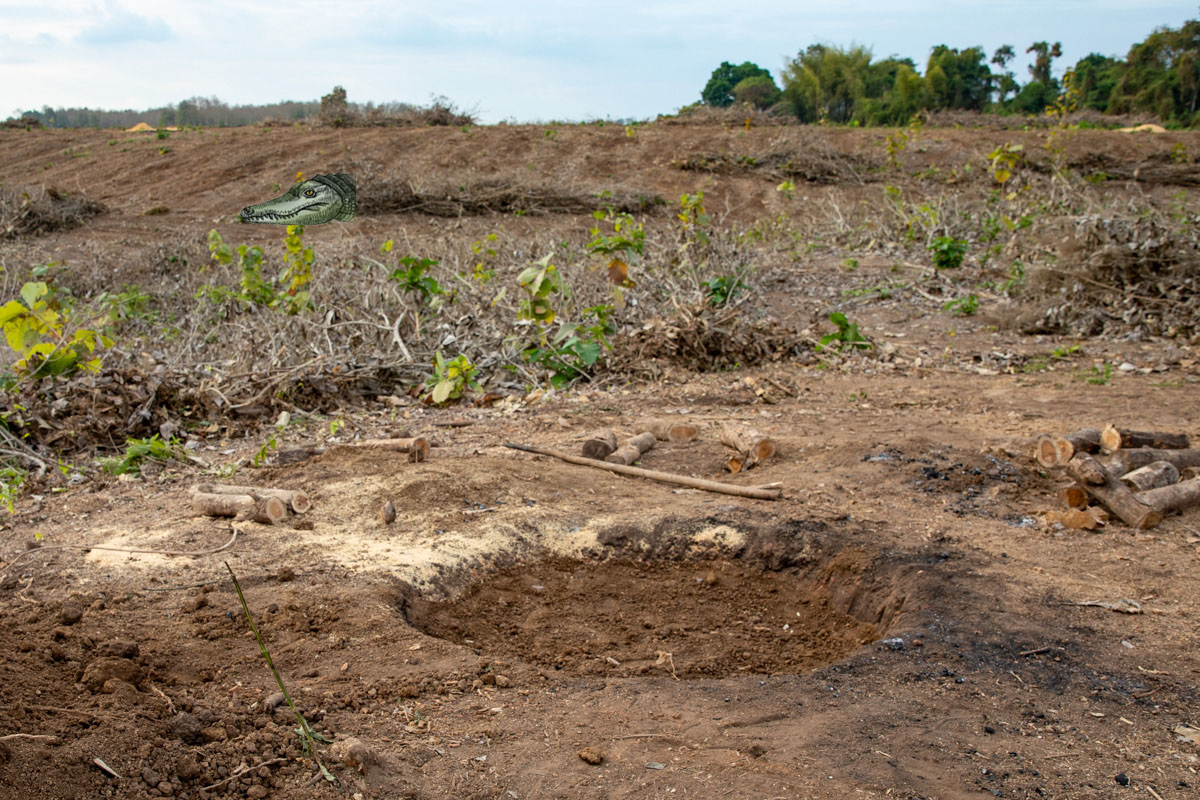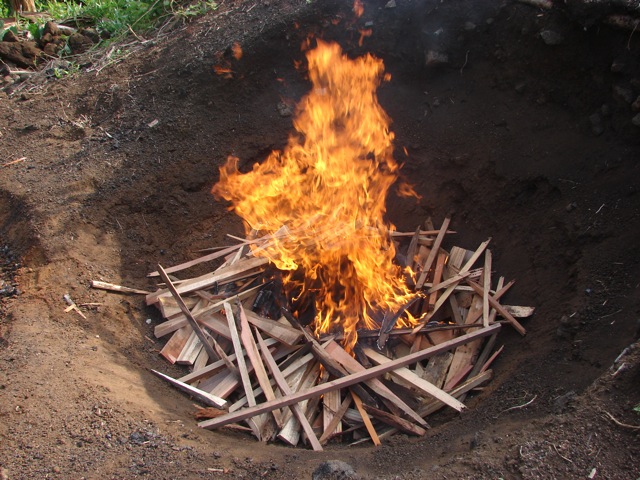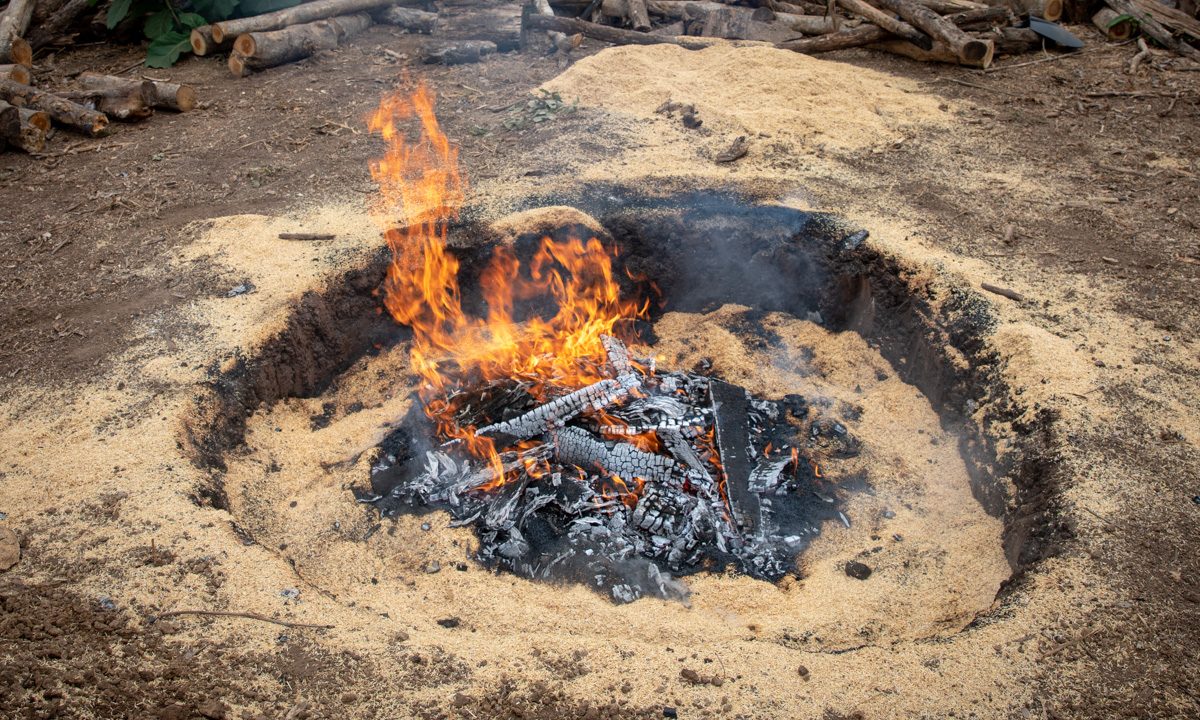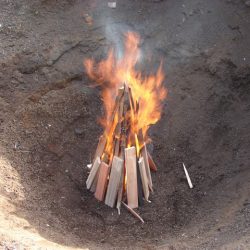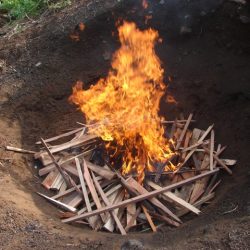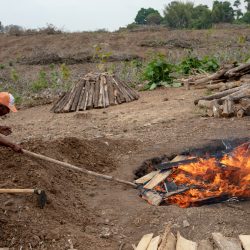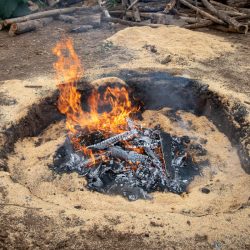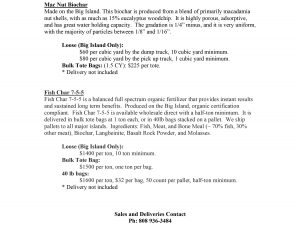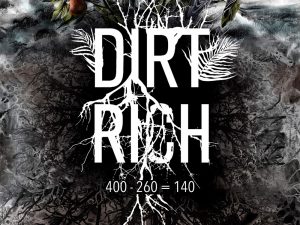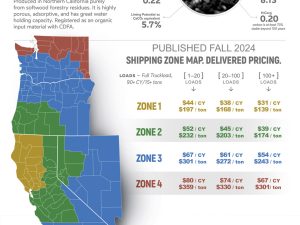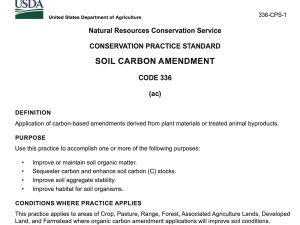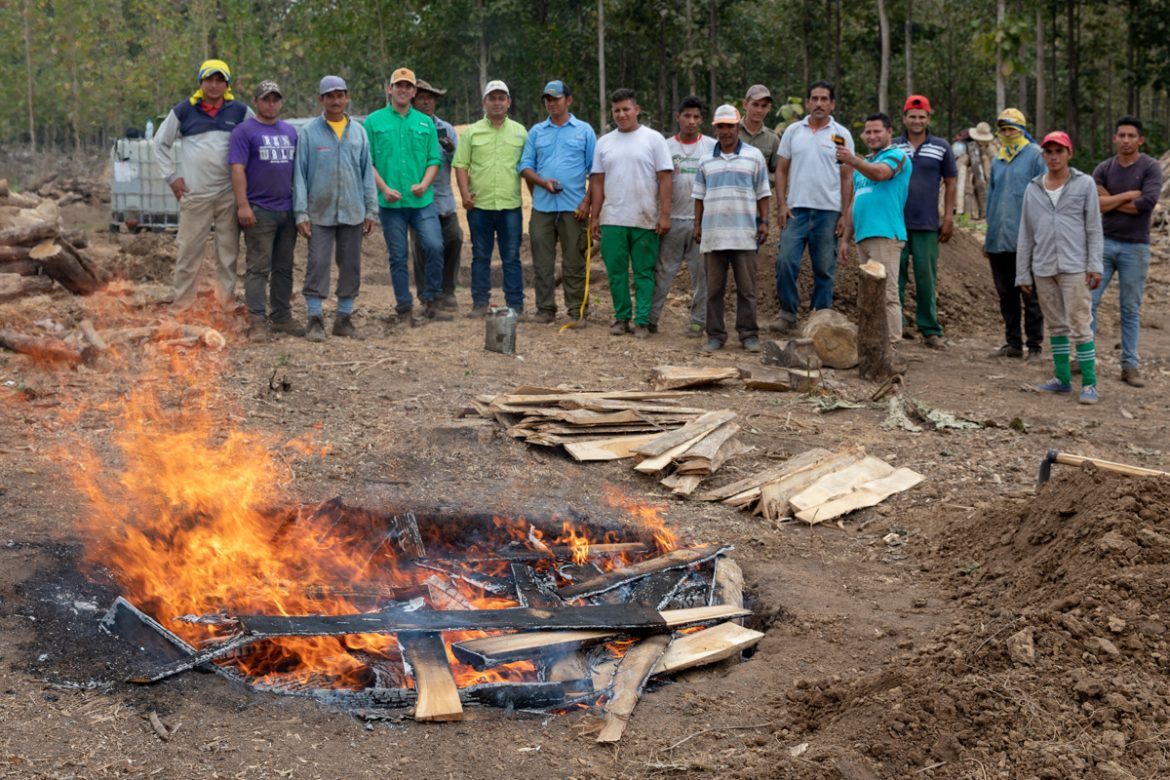
How to make biochar. Is it more efficient using an open fire in a pit, or to use a covered smoldered slow burn?
There was recently a great opportunity to put these biochar production methods to a test against each other, and here is the report.
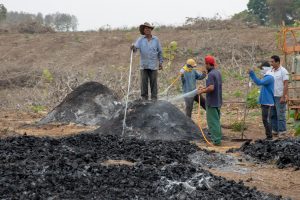
Smoldered Pile Method at harvest
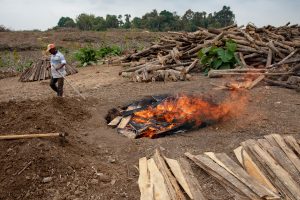
Open Pit Method in action
I visited Ecuador in October to work with a budding biochar production project, Tectocarbon. They have a great team, and it was an honor to work with them. Which made my fear all the more intense. I was about to have my little fire trick tested like never before, in front of a live audience of experienced professionals. The method I was using, what I call the Open Pit, was something I had developed in my backyard starting in 2008 (and like convergent evolution, its happened elsewhere too). Their method, a Smoldered Pile, had been refined over unknown generations.
The Open Pit method was developed to be a clean burning and simple means of producing biochar for use in soil. The Smoldered Pile method is widely practiced as an efficient means of producing charcoal for fuel.
I was confident that the open pit method I was about to show them would have cleaner emissions, as the smoke and gases produced are consumed by the open flames, reducing emissions to mostly CO2 and H2O. Whereas with a smoldered pile, smoke and gases leave without being consumed by flame, and are emitted in longer carbon chains that have a more negative impact on the atmosphere. But while reducing emissions sounds cool in an altruistic kinda way, is that a luxury that could be afforded here?
And the open pit is expected make a better quality biochar. A smoldered fire, in my experience, made charcoal that was good for cooking, but was not as good for use in soil. In a smoldered fire, the temperature is generally pretty low, and smoke can condense on the surface of the charcoal, leaving it sooty. While the lower temperature charcoal can make for a better fuel product (more heat value), it will have a lower adsorption, less porosity, and the charcoal will be less baked (not all the carbon will be properly transformed, much of it still left in forms that are subject to decay).
But, there is no way my method could be more efficient in yield, or easier in process, right? If it was, they’d have figured this out a long time ago, like generations ago.
So we met out in a dusty plantation of teak (Tectona grandis), a land holding of Forescan company. Dry season was nearing it’s end, the land had been harvested of it’s prior teak planting, was about to be planted again, and there were piles of waste wood waiting to be burned one way or another. The holes had been dug already, awaiting the gringo to show up and make some magic. And it went something like this:
Smoldered Pile Method
Wood is piled in a dome or stretched dome, with kindling on the inside, which is then lit. As the fire inside the pile begins to get large enough to set into the bigger logs, the pile of wood is then covered with a layer of organic matter and/or soil. The smothered fire, which now has severely restricted air flow, burns slowly, producing smoke and steam, but no flame (it smolders). This continues with regular monitoring for about 3 days. During this time the outer layer is patched up with more covering (rice hull in this situation) and the wood becomes charcoal. The pile of charcoal is then harvested by breaking it open and quenching it with water.
Open Pit Method
Overview: dig a pit, start a fire, add wood at a rate that does not smother the fire into a smoky mess, but at a rate so fast that the fire is always near being smothered. In this manner charcoal that is created is then covered with wood, which becomes charcoal, which is then covered with wood, and so on. This continues until the pit is full, at which point the remaining wood on the surface is allowed to finish burning into char and ash. The whole thing is then covered with dirt in order to cool the glowing bed of charcoal, which is harvested the following day or later.
The Open Pit wins! But why?
It was hailed as being easier, faster, and producing a more porous biochar. The expert team finished about a half dozen fires by the next afternoon, and they agreed that they liked it better.
If this method was so quickly favored for producing biochar, why weren’t they already doing it? I think it is because in this area charcoal is sold primarily for cooking fuel, and this method it doesn’t necessarily make a better fuel charcoal. In fact, it produces a visibly lower value product for their primary market of cooking charcoal.
- The higher temperature of the open pit results in a charcoal that is more porous, but a lower density fuel product,
- And results in the charcoal being more brittle, more easily fracturing into smaller pieces.
- The Open Pit method generally requires harvesting by shovel (unless you make an above ground pit, or a metal cone), this harvesting by shovel breaks the brittle charcoal down into smaller pieces that are less desirable for cooking.
Open pit biochar production, shown during harvest
Ecuadorian Alligators and the Top Lit Open Fire
The Smothered Pile method, now replaced with the Open Pit method was used primarily for the larger diameter wood. There were also the “alligators”: big piles of thin branches, vines, and leaves. These big piles were a tangle to unravel, and were being burned to clear the ground for planting. Rather than burning the “alligators” to ash, it is still possible to burn these piles into biochar using an Top Lit Open Fire method.
Top Lit Open Fire: Light the pile from the top, on the downwind side, let it burn top-down to a pile of char, when the high dancing yellow flames are mostly done, attack the pile with water and rakes before it goes to ash.
The first, and key step is to build piles open, loose and well ventilated: at least 50% air space. You should be able to see through all but the very largest piles. This assures that adequate air will reach the volatiles, fully combusting them to clean the burn and maintain heat. Smoke is wasted heat. Only the very top of the pile should have more densely packed material to assure that combustion is well established.
A more detailed description of the Open Pit Biochar Production method :
1.) In the bottom of an earthen pit, start a fire. Grow the fire till larger wood can be added. Get it real hot with kindling and small to mid size wood (best if less than 4″). Then, when the fire it hot and a layer of coals have begun to form,
2.) If all of your feedstock is thin diameter, move to step 4.
3.) I you have large diameter wood, then stop adding kindling or small diameter wood. Continue adding medium diameter wood and start adding the thicker logs. 6″ diameter and less is no problem. Larger than 6″ diameter may need to be split. This will continue till the pit is nearly full.
4.) The donut, volcano, the chimney… This is really important: when adding the wood into the pit, add the wood in such a way that you leave an opening through the middle of the pit, forming a chimney of sorts. A donut shape that shoots flames like a volcano. This helps organize the draft.
5.) When the pit is nearly full, stop adding the large diameter logs and add only mid size and smaller.
6.) Small diameter wood can be added until the pit has been filled well beyond the rim, it will shrink down a bit.
7.) Stop adding wood.
8.) Tend to the fire with a long stick as it transitions towards a glowing bed of coals. Move larger pieces into a pile in the middle, and tending to the edges with light sprays of water or thin coverings of sawdust or rice hull.
9.) When most of the wood on top has become char, and/or the wood-gas flames have subsided, then remove any unburnt wood from the top layer, and finish the fire.
10.) To finish the fire, I prefer to cover it with a layer of soil 4″ – 6″ deep, thus choking off the oxygen. It can be covered with a metal lid if preferred. By covering the pit, the char will be cut off from oxygen, snuffed out, and allowed to bake for a while longer in the pit, slowly cooling. When time does not allow for this, then the biochar pit can be quenched with water.
This method is described here on the website in a few other places as well. Follow these links if you are interested: One of the original posts on How to Make Biochar with Only a Match, or a more recent post Atoll Growing: biochar from coconut husks for better toilets and bigger bananas.
There are many small details that are not mentioned, such as craters in the cap, breathing soils, bamboo bombs, pipe tricks… And there is a growing trend of combining the Top-Lit techniques with the pit. Where woody material is loosely stacked in a pit, lit from the top, then when it has burned down to mostly embers, the pit is fed as normal until it reaches it’s capacity.
In Conclusion
Sometimes simplicity is a source of strength. There are machines more advanced, more complex. But this simple technique needs incredibly little to get started and to continue. Every year, all over the world, fires are lit to clear brush, to clean up the trimmings of last harvest to make room for the next. This is a simple fire technique that could have profound impact. But it all starts with the recognition of biochar as being a product of value in soil, as is being pioneered in Ecuador by Tectocarbon. Otherwise the fires that are lit will produce either ash or cooking fuel. On this particular plantation, a land holding of Forescan, several tons of biochar per hectare will be produced and applied with every harvest. Expand that out on paper and it starts adding up. But again, it only expands out in the real world when prompted by a recognization of the value of biochar for increasing soil organic matter, improving crop yield, and reducing CO2 in the atmosphere.
– Josiah Hunt
CEO | Pacific Biochar Benefit Corporation
Thank you for taking part
Acknowledgments to the Tectocarbon team for their good work building soil carbon and pioneering better management practices in growing Tectona grandis (teak), and to Peter Hirst as a contributing editor.
